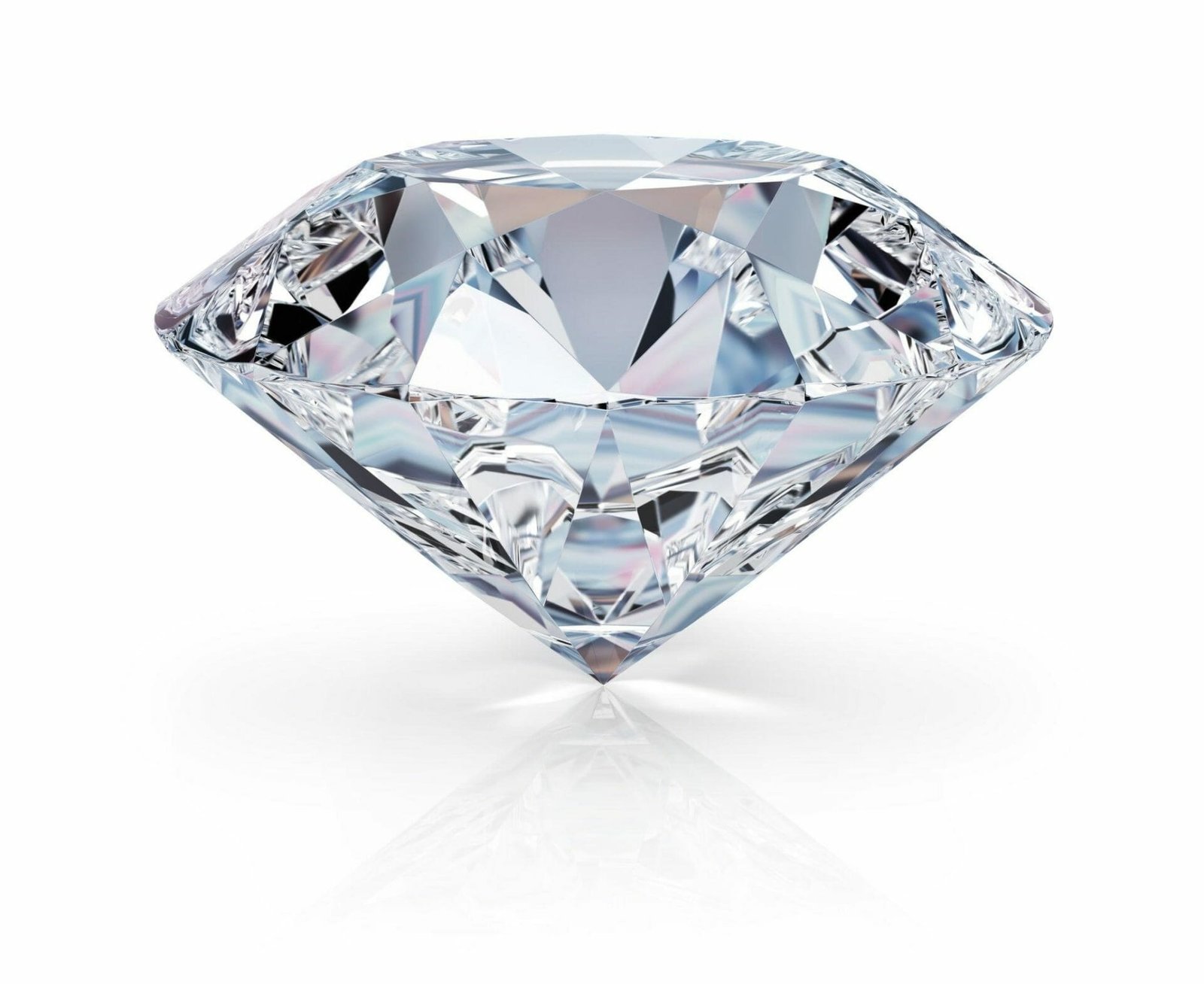
Fake vs Real Diamonds – 8 Tested Steps To Tell If a Diamond is Real (2022)
The difference between a fake diamond and a real one may not be immediately apparent, but there are several ways to tell if a diamond is real or not. Real diamonds are mined from the earth and have unique properties that make them valuable. Fake diamonds, on the other hand, are created in a lab and lack these properties.
If you’re interested in the history and uniqueness of a natural diamond, then a real diamond is probably the way to go. But if you’re more concerned with price and don’t mind that your diamond wasn’t created by nature, a fake diamond might be a better option. Ultimately, the decision between a real or fake diamond comes down to personal preference.
So, which is better? There is no specific answer to this question. Each type of diamond has pros and cons, so it’s important to do your research before making a purchase.
Table of Contents
What is the Difference between a Fake Diamond And a Real Diamond?
When it comes to diamonds, there are two main types: real and fake with their differences being the following:
- Fake diamonds, also called cubic zirconia or moissanite, and have very little value are man-made, whereas Real diamonds are made by nature and are considered valuable because of their rarity.
- Real Diamonds are very rare.
- Real diamonds will typically have more flawless facets than fake diamonds.
- The price of a real diamond is significantly higher than the price of a fake diamond.
- A real diamond will have double refraction, meaning that when light passes through the stone, it bends in two directions.
- A real diamond will emit blue light when exposed to ultraviolet light, while a fake diamond will either emit no light or yellow light.
Still confused? Don’t worry, we got you.
Fake Diamond
A fake diamond is a stone that is made to resemble a real diamond. The most common type of fake diamond is cubic zirconia, which is made from zirconium oxide. Cubic zirconia is relatively inexpensive and has a hardness that makes it difficult to tell apart from a real diamond with the naked eye.
However, under magnification, cubic zirconia crystals have different shapes than real diamonds. Other types of fake diamonds include moissanite and glass. Moissanite is made of silicon carbide and has similar physical properties to diamonds, but again can be distinguished from real diamonds under magnification.
Glass diamonds are usually cut in a round or marquise shape and are very low quality imitations. It’s important to be aware of fake diamonds because they are often sold as genuine stones. If you’re looking to buy a diamond, make sure you’re working with a reputable jeweler who can certify the authenticity of the stone.
Do you have a reliable jeweler?
How to Check Diamond Quality?
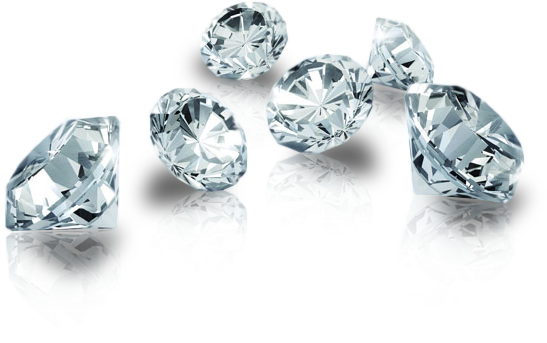
- If you’re in the market for a diamond, it’s important to know how to check diamond quality. There are a few key factors that determine the quality of a diamond, and by understanding these factors, you can be sure to choose a beautiful and high-quality stone. The first factor to consider is the cut of the diamond.
- The cut affects the symmetry, brightness, fire, and how sparkly the diamond appears. It’s important to choose a well-cut diamond because it will maximize the stone’s natural beauty. Next, take a look at the colour of the diamond.
- The most desirable diamonds are those that are absolutely colourless, but stones with slight tints of yellow or brown are also beautiful and less expensive. The clarity of the diamond is another important factor. Most diamonds have some small imperfections called inclusions, but these shouldn’t be visible to the naked eye.
- However, if there are large or numerous inclusions present, it can affect both the look and value of the stone. Finally, carat weight is another element that determines quality. A higher carat weight means a larger stone, but keep in mind that two diamonds of different sizes can have similar carat weights depending on their specific gravity (the density of the material).
- So don’t just focus on size when choosing your perfect diamond! Keep these factors in mind when checking diamond quality, and you’ll be sure to find a stunning and high-quality stone that you’ll love for years to come!
Top 8 Expert ways to test if a diamond is real or fake
When shopping for diamonds, it is important to be able to tell the difference between a real diamond and a fake one. There are many ways to spot a fake diamond, but there are also some ways that fake diamonds can be made to look very convincing. Here are some tips for telling the difference:
1. How to Tell If a Diamond is Real with a ''Flashlight''?
When it comes to telling if a diamond is real, there are a few at-home tests you can try. The most common way to test if a diamond is real is by using a flashlight.
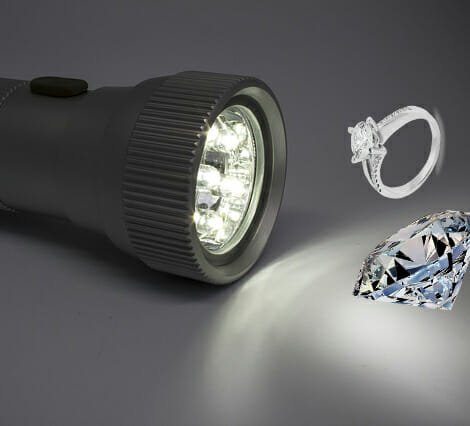
To do this test;
- Hold the suspect diamond up to your eye and turn off all the lights in the room.
- Next, shine a flashlight directly on the diamond.
- If the diamond is real, you should see tiny rainbow colours scattered throughout the stone. These colours are actually reflections of light inside the diamond, and they’re known as ‘brilliance.
2. How to Tell If a Diamond is Real with a ''Fog test''?
Another way to tell if a diamond is real is by doing what’s called the fog test.
To do this;
- Breathe on the stone and then observe how quickly the fog clears.
- If it’s a real diamond, the fog will clear almost immediately.
- However, if it’s fake, the fog will linger on the surface of the stone for longer periods of time before eventually clearing.
So there you have it – two simple ways to test if a diamond is real using nothing more than a flashlight and your breath!
3. How to Tell If a Diamond is Real with a ''Mirror''?
When it comes to diamonds, the old saying “if it’s too good to be true, it probably is” definitely applies. So how can you tell if that diamond you’re looking at is the real thing?
Here’s a quick and easy way to find out using just a mirror.

- Take a close look at the diamond and see if there are any flaws or blemishes visible on the surface. If there are, then it’s likely that the diamond is real. However, if the stone appears to be flawless, then it may be fake.
- Next, hold the diamond up to your ear and listen for a faint ringing sound. This is called “tinnitus” and is caused by vibrations bouncing off of the facets of a real diamond.
- Finally, take a small handheld mirror and hold it up so that you can see both the front and back of the diamond at the same time.
- If what you see in reflection looks symmetrical, then chances are good that you’re looking at a fake stone. Real diamonds will almost always have some sort of asymmetry when viewed in this way due to their complex structure.
Now that you know how to tell if a diamond is real with just a mirror, put these tips to use next time you’re out shopping for jewelry!
Do you actually want to invest in the right thing?
4. How to Tell a Real Diamond by ''Eye''?
When it comes to diamonds, there are a lot of ways to tell if a diamond is real or fake. But, one of the most common and easiest ways to tell if a diamond is real, is by eye. Here are a few things you can look for when trying to determine if a diamond is real:
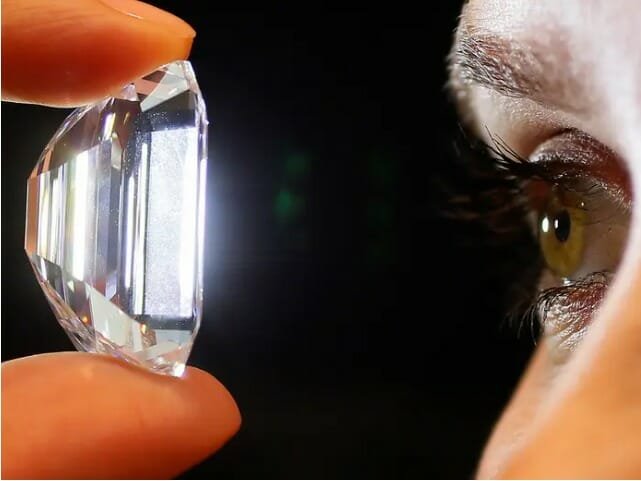
1. Check the Reflection
Take a close look at the diamond and see how it reflects light. A real diamond will reflect light in a very distinct way. The light should be bright and sparkle in all directions. If the reflection looks dull or off, then chances are the diamond is not real.
2. Inspect the Cut
A well-cut diamond will have clean lines and sharp angles. If the cut is poor, then it’s likely that the diamond is not real. Also, take note of how many facets (the flat surfaces on a diamond) are present on the stone. A real diamond will have 58 facets, while a fake stone may only have 16 facets or less.
3. Look for Clouds
Another way to tell if a diamond is real is by looking for clouds inside the stone. Real diamonds are often included with small imperfections called “clouds.” These clouds actually help give diamonds their unique sparkle! So, if you see any cloudy areas inside the stone, then it’s likely that the Diamond is Real.
However, keep in mind that some fake diamonds may also contain these types of imperfections, so this method alone cannot be used to definitively determine whether or not a stone is real.
4. Bounced off It
Another test you can do to check if your Diamond is real , is to put It under water And see if it bounces off the surface of the water . This test works because diamonds are much denser than water , so they tend to sink rather than float. If your diamond sinks straight to the bottom of the glass, it ‘s probably fake.
5. Use Foggy Glasses
This test involves holding your diamond up to a pair of glasses that have been fogged up with your breath. Fake diamonds will usually disperse the fog much quicker than real ones will because of their lower density levels.
6. Try The Tooth Test
This test involves putting your diamond up against your tooth and seeing if it leaves a mark on your tooth.
Now can you save yourself from wasting your money?
5. How to Test a Diamond With a ''Multimeter''?

When shopping for diamonds, it is important to be able to identify a real diamond from a fake. One way to do this is to test the diamond with a multimeter. A multimeter is an electrical testing tool that can measure the conductivity of a material.
Diamonds are extremely good conductors of electricity, so if you put the probes of a multimeter on either side of a diamond and get a reading, it is most likely a real diamond. To test a diamond with a multimeter, first make sure that the probes are clean and then turn on the power. Touch one probe to each side of the stone being tested.
If the needle on the multimeter moves, then you have found yourself a real diamond!
6. How to Test Real Diamond in ''Sunlight''?
A diamond is a piece of carbon that has been subjected to extreme heat and pressure. This process creates a crystal structure that is incredibly strong and durable. Diamonds are the hardest natural material on Earth, which makes them ideal for use in jewelry.
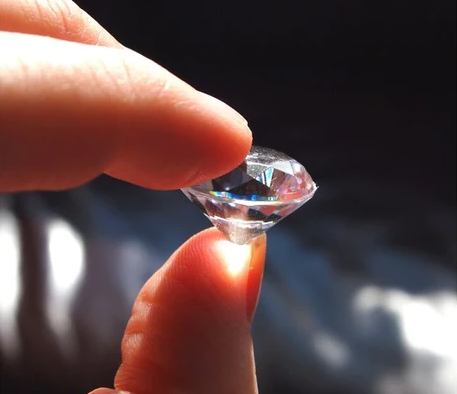
When a diamond is cut and polished, it can reflect light in a variety of ways. The most common way to see a diamond’s sparkle is by looking at it in sunlight. Sunlight contains all the colors of the rainbow, so when it hits a diamond, the stone can reflect back all those colors at once.
This effect is known as dispersion, and it’s what gives diamonds their unique fire and brilliance. If you’re lucky enough to own a real diamond, be sure to take care of it! Store your diamond jewelry in a soft cloth pouch or wrapped in tissue paper to prevent scratches.
When cleaning your diamonds, use only mild soap and warm water; avoid harsh chemicals or detergents, as they can damage the surface of your stone.
Diamond Reflection Test
When it comes to diamonds, there are a few things that set them apart from other gemstones. For starters, diamonds are the hardest known natural substance on Earth. They’re also extremely resistant to heat and wear down very slowly.
But perhaps one of the most unique properties of diamonds is their ability to disperse light in a distinctive way. This dispersion of light is what gives diamonds their characteristic sparkle. When a diamond is cut and polished correctly, the facets (or flat surfaces) act like tiny mirrors.
They reflect light back and forth internally, and then bounce that light back out through the top of the stone. The result is a dazzling display of brilliant white light. In addition to their sparkle, real diamonds also have other optical properties that make them stand out from imitations or simulants.
For instance, when viewed under ultraviolet (UV) light, most fake diamonds will fluoresce brightly in shades of blue or green. But real diamonds will usually emit a faint yellowish glow instead. This property can be used as a quick way to test if a diamond is real or not.
So, next time you’re admiring a beautiful diamond ring or necklace, take a moment to appreciate all the unique qualities that make this gemstone so special!
Now can you test your diamond at home?
7. How to Check Real Diamond at ''Home''?
Hold the thread above the water and watch to see if it bends toward or away from the glass. If the water has a positive charge, then the thread should be attracted to it. When testing for a static charge, one of the most common ways is to use a piece of thread or hair.
By holding the thread above the water and watching to see if it bends toward or away from the glass, you can get an accurate reading on whether or not the charge is positive or negative. If the water has a positive charge, then the thread should be attracted to it.
One of the most common questions people ask is how to properly drop a thread or hair onto the surface of a stone. The answer is actually pretty simple – hold the thread or hair above the stone and drop it onto the surface of the stone. That’s it!
But there are a few things to keep in mind to ensure that your dropped thread or hair looks its best.
- Make sure that the thread or hair is clean and free of any knots or tangles. If you’re using human hair, it’s best to use one that has been recently washed.
- Be careful not to drop the thread or hair too hard onto the surface of the stone – you don’t want to break it!
- Take into account the size of the stone when dropping your thread or hair – if it’s a small stone, you’ll need to use a smaller amount of thread or hair so that it doesn’t overwhelm the surface. And that’s all there is to it!
With just a little bit of care and attention, you can easily drop a thread or hair onto any type of stone surface without damaging it. If the strand moves across the surface of the stone, it’s likely to be a fake diamond because genuine diamonds have more friction and will hold onto the strand.
When it comes to diamonds, the “4 Cs” (cut, color, clarity, and carat weight) are important factors in determining a stone’s value. However, there’s another factor you should keep in mind when trying to spot a fake diamond: how easily the strand moves across the surface of the stone. If the strand slides right off with little resistance, it’s likely because the diamond has been treated with oil or other substance to make it appear shiny and lustrous.
On the other hand, genuine diamonds have more friction and will hold onto the strand better. So if you’re ever in doubt about whether a diamond is real or fake, just give it a quick test with a piece of string!
8. How to Tell if a Diamond is Real with a ''Magnifying Glass''?
One way to test the authenticity of a diamond is by looking for tiny scratches on the surface of the stone, known as “inclusions. By using a magnifying glass, you can inspect the diamond for these small imperfections. If the stone is real, it will likely have some inclusions visible under magnification.
However, if the diamond is fake, it may be completely free of inclusions or have very few imperfections.
Inclusions are tiny imperfections that are found inside diamonds. They can be anything from other minerals that were present when the diamond was formed, to tiny fractures that have occurred over time. While most diamonds will have at least some inclusions, you should be able to see them without the help of a magnifying glass.
If you can’t see any inclusions, or if the inclusions seem too perfect, then the diamond is most likely to be a fake one.
Why are Fake Diamonds Cheaper Than Real Diamonds?
Fake diamonds are cheaper than real diamonds for a variety of reasons.
- First, fake diamonds are typically made from lower quality materials than real diamonds.
- Second, the process of creating fake diamonds is usually less expensive than the process of creating real diamonds.
- Finally, fake diamonds are often sold by companies that don’t have the same overhead costs as companies that sell real diamonds.
Conclusion
The first thing to look at is the price. Real diamonds are very expensive, so if you see a diamond that is being sold for much less than its value, it is likely a fake. Next, take a close look at the diamond itself. A real diamond will have few imperfections and will be extremely sparkly. Fake diamonds often have more flaws and may not be as sparkly. Finally, ask to see a certificate of authenticity from a reputable jeweler. This will guarantee that the diamond you are buying is real.
We hope that these factors will help you to understand between fake vs real diamonds. Keep these expert steps in mind when checking diamond quality, and you’ll surely find a stunning and high-quality real diamond that you’ll love for years to come!
